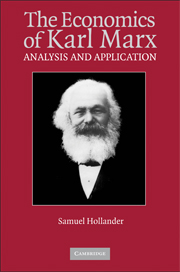Book contents
- Frontmatter
- Contents
- Preface
- Introduction
- Part One CAPITAL: PRINCIPLE FEATURES OF THE MARXIAN “CANON”
- Part Two ORIGINS: MARX IN THE 1840s
- Part Three A “SECOND DRAFT” OF CAPITAL: THE GRUNDRISSE 1857–1858
- 8 1857–1858 I: Surplus Value
- 9 1857–1858 II: Value “Realization”
- Part Four A “THIRD DRAFT” OF CAPITAL: THE ECONOMIC MANUSCRIPTS 1861–1863
- Part Five TOPICS IN APPLICATION
- Conclusion: A Recapitulation and Overview
- Appendices
- Bibliography
- Index
8 - 1857–1858 I: Surplus Value
Published online by Cambridge University Press: 25 June 2009
- Frontmatter
- Contents
- Preface
- Introduction
- Part One CAPITAL: PRINCIPLE FEATURES OF THE MARXIAN “CANON”
- Part Two ORIGINS: MARX IN THE 1840s
- Part Three A “SECOND DRAFT” OF CAPITAL: THE GRUNDRISSE 1857–1858
- 8 1857–1858 I: Surplus Value
- 9 1857–1858 II: Value “Realization”
- Part Four A “THIRD DRAFT” OF CAPITAL: THE ECONOMIC MANUSCRIPTS 1861–1863
- Part Five TOPICS IN APPLICATION
- Conclusion: A Recapitulation and Overview
- Appendices
- Bibliography
- Index
Summary
Introduction
Marx's 1000-page manuscript known as the Grundrisse (Outlines of the Critique of Political Economy), its existence announced to the world only in 1923, was written during the second half of 1857 and early 1858 for “self-clarification” (Rubel 1968: xc, 173–4; McLellan 1970: 35–6; MECW 28: xix; MECW 29: 261; MECW 40: 610n 250). Here we see Marx struggling with the appropriate ordering of his material. Repeatedly we find references to topics that would have to be fitted in at some other stage of the argument, which promise is not always fulfilled at this time (see in particular MECW 28: 96, 213, 217, 334, 336, 354, 376–9, 442–7, 454, 456), numerous repetitions, significant variations and contradictions, and notes of all kinds interspersed not always coherently within the text. Inevitably some passages remain distressingly opaque. Some commentators tend to play down the document's positive analytical accomplishment: “It provided a foundation for Marx's later critico-theoretical development, but no more” (Oakley 1979: 287). Orzech and Groll recognize that “[t]he basic elements of Marx's theoretical system are already delineated in Grundrisse,” but add “although in a very unpolished and unfinished form” (1989: 58). McLellan considers the Grundrisse as “the center-piece of Marx's thought” (McLellan 1970: 36, 41), but he refers to materials extending beyond the strictly economic with which we are largely concerned.
- Type
- Chapter
- Information
- The Economics of Karl MarxAnalysis and Application, pp. 235 - 267Publisher: Cambridge University PressPrint publication year: 2008



